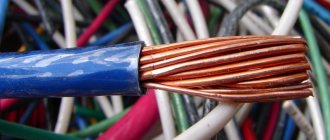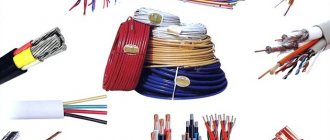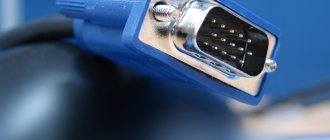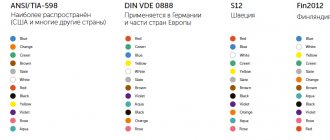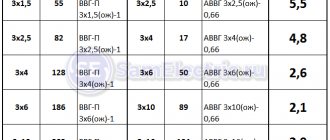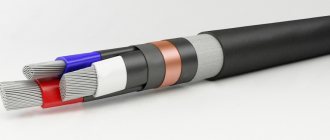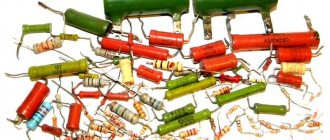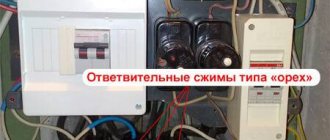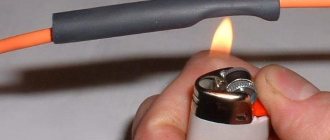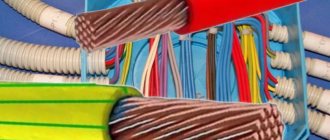The existing variety of cables and wires for the most part amounts to three-digit numbers. Therefore, it is not possible to describe the entire range in one article.
Meanwhile, it is not at all necessary to describe all types of cables and wires and their purpose. It is enough to have an idea of labeling standards and be able to extract the necessary information from the characteristics in order to select the appropriate option from the variety of cable products according to its purpose.
Let's consider the main points on how you can learn to distinguish electrical wires among an array of such products, and also provide descriptions of the most popular wires and cables.
Structural basis of the cable product
The design of the cable or electrical wires determines the technical and operational characteristics of the product. Actually, the design of cable or wire products is, in most design variations, a fairly simple technological approach.
Classic version:
- Cable insulation.
- Core insulation.
- Metal core – solid/bundled.
A metal core is the base of a cable/wire through which electric current flows. The main characteristic, in this case, is the throughput, determined by the cross-section of the core. This parameter is influenced by the structure - solid or bunched.
Such a property as flexibility also depends on the structure. In terms of the degree of “softness” of bending, stranded (bundled) conductors are characterized by better properties than single-core wires.
The structural design of the current-carrying part is traditionally represented by “beam” or “solid” (monolithic). This has implications, for example, in relation to flexibility properties. The picture shows stranded/bundled wire type
The cores of cables and wires in electrical practice, as a rule, have a cylindrical shape. At the same time, it is rare, but there are several modified shapes: square, oval.
The main materials for the manufacture of conductive metal cores are copper and aluminum. However, electrical practice does not exclude conductors whose structure contains steel cores, for example, a “field” wire.
While a single electrical wire is traditionally built on a single conductor, a cable is a product where several such conductors are concentrated.
Core material
In domestic conditions, aluminum, copper and aluminum-copper are most often used. Everything is clear with the first two, but what is aluminum-copper? This is not an alloy, as you might think at first, since heavy and light metals combine extremely poorly, but a composite material consisting of an aluminum core and coated with a layer of copper on top. Why combine these two materials will become clear after considering their properties.
Aluminum wires
Aluminum is an excellent material: lightweight, cheap, has quite decent electrical conductivity, transfers heat well, and is chemically resistant. However, there are several “buts” that significantly tarnish the reputation of this metal.
1. Aluminum wire cannot be flexible. Remember how well a wire made of this material breaks if you bend it several times. The conclusion is simple - such wires are used only in stationary installations and where there are no sharp angles of rotation of the cable during installation.
2. Aluminum oxidizes in air. Aluminum oxide is a dark-colored, refractory film that forms on the surface of a metal and is a dielectric. The contact points may seriously interfere with the flow of electric current. This results in excessive overheating and the risk of losing contact at the connection points.
3. Aluminum is an excellent conductor, but only if it does not contain impurities, which is very difficult to achieve. Compared to copper, this metal has a conductivity that is one and a half times less.
Copper wire
Copper, along with numerous advantages, has no fewer disadvantages.
Advantages : conductivity is higher than that of aluminum, flexibility, does not form an oxide film. The thickness of the core depends on the flexibility. Aluminum conductors cannot be thinner than 2.5 mm², and copper conductors can be made with a thickness of 0.3 mm².
Disadvantages : high cost, high density and therefore weight, impossibility of direct connection with aluminum conductors. Upon contact, these two metals form a galvanic couple, and the resulting currents destroy the contact. That is why, if contact is necessary, special connection terminals are used.
Aluminum copper is a mechanical composite consisting of an aluminum core and a copper jacket, which occupies 10% of the core volume. Combines the positive qualities of aluminum and copper. Cons: in all respects it is inferior to conductors made of individual metals. Plus: low cost.
Wire and cable insulating component
An integral part of cable and wire products is the insulation of the metal current-carrying base. The purpose of insulation is quite clear - to ensure an isolated state for each current-carrying core, preventing the effect of a short circuit.
The insulating material in most cases is polyvinyl chloride, which has shown in practice quite acceptable qualities in the construction of widespread electrical networks.
Depending on the purpose of the cable (wire) products, the insulating part may have different designs.
The dielectric material can be:
- ceramics;
- glass;
- polyvinyl chloride;
- celluloid;
- polymers, etc.
In addition to purely electrical protection, the insulating material also provides mechanical protection, protecting the electrical wire (cable) from moisture and other destructive factors.
There is also a special insulating construction applied to electrical wires and cables, giving the products "armored" or "anti-chemical" properties.
Special design - “armored”, reliably protects the internal structure, prevents moisture penetration, acts as a buffer against mechanical overloads
Recycling after use
Despite the long service life of the cables (from 15 to 30 years), they all need to be replaced after this period has expired. After this, the cables must be disposed of and recycled. Searching for wires and delivering them to scrap metal collection points allows us to partially solve the problem of obtaining primary raw materials. Collection points accept scrap:
- household;
- control;
- power;
- special cables.
The price per kilogram of scrap is determined:
- The quality of supplied raw materials.
- The percentage of a particular metal.
- Purity – the amount of contaminants and oxides.
- The integrity of the sheath, as well as the complexity of further processing of cable scrap.
- Volume of recyclable materials - the more cable scrap is handed over, the higher the price per kilogram.
Distinctive features of cable and conductor
Often, in non-professional practice, the term “cable” is equated to any type of electrical wire. Meanwhile, the concepts of “cable” and “wire” should be distinguished. And, first of all, the separation involves the factor of transmitted power.
A cable is a product whose structure combines at least three conductors in insulation, additionally protected inside the shell with a special material - parchment, rubber, lead, etc.
Wire is a product consisting of one, maximum five conductors (cord), in the latter case, united by a common casing.
Classic power cable structure: 5 – protective sheath of the assembly; 4 – armored layer; 3 – common shell of current-carrying metal conductors; 2 – insulation of the conductors themselves; 1 – metal conductor
The priority use of cables is industrial and economic facilities. Wires are actively used in everyday life, as well as in other areas.
Separately, bare wires that do not have insulation should be highlighted. The main use of such products is in the installation of centralized power lines.
Power cables with cross-linked polyethylene insulation for voltage 1 kV
Cable types:
APvVG; PvVG; APvVGng; PvVGng; APvBbShv; PvBbShv; APvBbShng; PvBbShng; APvBbShp; PvBbShp
Shell:
• for APvVG, APvBbShv, PvBbShv, PvVG - made of PVC plastic, flame retardant when laid alone;
• for APvVGng, PvVGng, APvBbShng, PvBbShng - made of PVC plastic with reduced flammability, non-flammable when laid in bundles;
• for APvBbShp, PvBbShp - made of polyethylene. Used for laying:
Basic types of electrical wires
Electrical network wires are classified based on load power and application conditions. For everyday use, the use of the following types of wires is typical: PBPP, PBPPg, APUNP, PPV, APPV, APV, PV1 - PV3, PVS, ShVVP.
Type #1 - PBPP wire (flat)
A product with a polyvinyl chloride insulating sheath, under which a solid copper core is hidden. This electrical material is manufactured with conductors with a cross section of 1.5 - 6.0 mm2.
The flat design is a fairly convenient type of electrical conductor for use in household construction of power lines. Thanks to the copper current-carrying part, it is possible to connect a powerful load
It is allowed to use PBPP wire in ambient temperatures from -15°C to +50°C. The wire is designed for the installation of networks with a voltage not exceeding 250 V. The traditional use of PBPP is the installation of socket lines in the domestic sector. This wire is often used to organize wiring in an apartment.
Type #2 - modification of PBPPg
In fact, the product is presented in the same design as described for the PPPP, with the exception of one nuance, which is indicated by the letter “g” of the standard marking.
This nuance lies in the more pronounced properties of flexibility. In turn, improved flexibility properties are provided by the core structure of this type of wire, which is “bundled” and not solid.
A modified version in a two-wire version, which uses the structure of a “bundle” current-carrying part. This option is also popular in households
Type #3 - aluminum conductor APUNP
The presence of an aluminum conductor under the insulation is directly indicated by the product marking - the first symbol “A”. This product is produced in the core cross-section range of 2.5-6.0 mm2.
Electrical aluminum wire is the simplest design of all existing options. It has a low price on the market, but at the same time it has low quality
This type of conductor is not recommended for use by professional electricians. The only advantage of this brand is its low cost. However, for the construction of temporary low-load circuits it is quite acceptable to use.
Type #4 - two-three-wire PPV
A product of a two- or three-conductor configuration, where the current-carrying conductors are placed under PVC insulation and held next to each other by means of an insulating jumper based on the same polyvinyl chloride.
At first glance, this type of wire resembles a glued pair. However, the connection of the pair is maintained by a PVC jumper running along the entire length at the point of contact of the insulation
Wire strands (copper) can have a cross-section in the range of 0.75-6.0 mm.
According to the technical specifications, operation is maintained at frequencies up to 400 Hz at voltages up to 450 V. Temperature limit -50/+70°C.
Type #5 - variety under the APPV brand
In fact, the same type of performance as demonstrated by the PPV brand, with the exception of the presence of aluminum conductors instead of copper conductors. It is manufactured in different sections, starting from a section of 2.5 mm2.
Almost a complete analogue of PPV, if you do not consider the material of the current-carrying part. This modification uses aluminum wires, which reduces the cost of the product, but somewhat reduces the performance
This type of electrical wire is widely used in a wide variety of installation cases. It is allowed to use APPV for open-type wiring devices.
Type #6 - APV aluminum with PVC insulation
It is produced in two configurations of cores - single-cast or bundled (multi-core).
At the same time, the single version is represented by products where the cross-section range is 2.5-16 mm2, and the multi-core version is available in the range of 25-95 mm2.
A variation of “bundled” aluminum is another type of the whole variety of electrical wires, which is used quite often in the practice of constructing electrical lines
This is one of those modifications that can be used in high humidity conditions. A wide temperature range is supported - from -50°C to +70°C.
Type #7 - modification PV1 - PV5
In fact, it is an analogue of automatic reclosure, but is produced exclusively with copper conductors. The difference between indexes 1 and 5 is that the first option is a product with a solid core, and the second option is, accordingly, multi-core.
We can say that there is an automatic reclosure design, but the conductors are made exclusively of copper. In all other respects, the difference is practically unnoticeable. A specific type used for specific circuit designs
This variety is often used when assembling control cabinet circuits. Supplied with multi-colored insulation.
Type #8 - PVC patch cord with PVC insulation
A type of conductor representing the configuration of an electrical cord. Available with a number of cores 2-5 in the cross-section range 0.75 - 16 mm. The structure of the cores is multi-wire (bundled).
A constructive version of the “cord” for household electrics. Indeed, this “cord” is often used to connect relatively powerful household appliances. Provides a convenient connection option due to color separation
Designed for operation in networks with voltages up to 380 V at a frequency of 50 Hz.
A special feature of the PVS design is a high degree of flexibility. However, the temperature regime is somewhat limited - from -25°C to +40°C.
Type #9 - flat cord SHVVP in PVC sheath
Another variety in a “corded” design. A variation in the number of wires united by a PVC sheath is supported, in the amount of two or three.
A flat two-wire “cord” is a pair of conductors enclosed in a polyvinyl chloride sheath. There is also a configuration with three conductors and a multi-core structure of the current-carrying part
The main application is the domestic sphere, outdoor wiring. Operating voltage up to 380 V, core structure – bundle, maximum cross-section 0.75 mm2.
Briefly about the main thing
Electrical cables are made with cores that are usually made of copper. However, there are also electrical products with conductive elements made of aluminum. The design of any electrical wire also includes an outer sheath and insulation of each core. Perhaps there is also an internal common shell and armor in the form of a metallized layer.
In homes, VVG and NYM wires are most often used. Less commonly used is PUNP electrical cable, which is of lower quality. Experts recommend using VBBShV electrical products in the ground. This is an armored wire.
The cable cross-section is determined by the current strength. To calculate it, divide the power of electrical appliances by the network voltage. In this case, it is additionally taken into account that 1 mm² of copper wire can pass 10 A.
